|
|
|
|
Products mentioned in this Article
--None--
|
|
|
|
|
|
|
|
|
 |
|
|
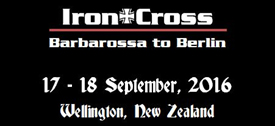 |
Iron Cross: Barbarossa to Berlin
Part One
with Tony Bates
"Great billowing clouds of dust streamed from the back of the Panzer IVs tracks. The commander rubbed the sleeve of his black jacket across his dust-encrusted goggles in a vain attempt to see forward.
|
He knew that the blurry red smudge to his left was the fiery ruins of Kharkov. His regiment’s orders were to reach the Donetz River and then swing north; his company was part of a southern pincer, which had smashed through Ivan’s overextended lines, during Generalfeldmarschall von Manstein’s counteroffensive. A report filtering back from the forward Aufklärung units indicated that the Soviets were panicking as their bridgehead across the Donetz was threatened.
The Panzer Commander smiled a secret smile behind his scarf. The image of the milling masses of Soviet infantry and tanks passed in front of his mind’s eye; several Russian armies would be caught in the German pincer, their commanders and Komissars exhorting them ever forward like blind sheep while their doom closed in from the flanks.
|
| His smile faded as he thought that only a few months prior he and his crew had been surrounded in a hamlet with an unpronounceable Russian name. The cold eating through all their clothing as they desperately tried to seek shelter from the never-ending storms; dreading to hear the swish-swish sound of more Siberian ski troops probing their pathetically weak defences or the whinnying of the hardy Cossack horses as the once vaunted Wehrmacht retreated yet again. He thought of his younger brother, an oberschütze with the 44. Infanteriedivision recently destroyed in Stalingrad. He remembered the last time they had met, near the small Lithuanian town of Lygumai during the heady days of Barbarossa’s rapid advance as they smashed their way through the Bolshevik masses. |
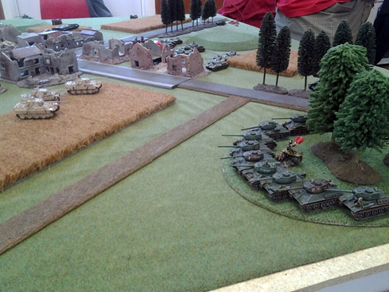 |
| The commander slid down into the Panzer’s turret confident in their eventual success; unaware that in little under a year he would be in command of a desperate fighting withdrawal in a valley in western Poland that his superiors believed had strategic significance and eight months after that he would be stumbling forward, bleary-eyed, arms raised, through the ruined streets of Berlin to an unknown future accompanied by laughter and jeers of Rodina zhdet vas fashistskuyu mraz!" |
|
"The motherland does indeed await you, fascist pigs. Pulling his service cap down further to cover his eyes in case anyone saw the moisture gathering, the Komissar grimaced. Mariya would have enjoyed the sight of the Germans marching into captivity, but they had killed her near Vitebsk. If Mariya wouldn’t see the Motherland again, then these fascists would never see their hated Fatherland again.
|
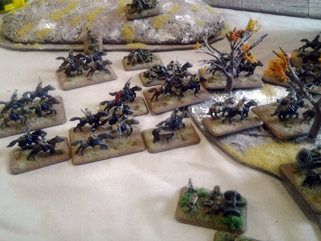 |
His hand shook briefly as he retrieved his hipflask. The vodka burned a fiery trail down his throat. He remembered the first time his hand had shaken, gripping his Tokarev pistol as he executed some boys from the Chelyabinsk oblast who had fled their positions. It wouldn’t be the last time he’d have to ‘motivate’ the troops to hold the line against the fascist invaders or to continue to push them forward. A feral dog began yapping nearby and his mind reeled back to the bitter fighting around Tula and how they’d unleashed dozens of dogs with explosives strapped to their backs, trained to attack German tanks; but the damned mutts couldn’t tell a Panzer from a T-34. |
|
Once General Winter and the fresh Siberian divisions had pushed the Fritzes back from Moskva, the Komissar had relished being transferred to Stalingrad far behind the lines to begin training new infantry troops. He smiled ruefully at his naivety. Stalingrad’s ruined landscape would be forever etched in his mind, as would the many faces of his comrades who had not taken one step back. The Komissar reached down and rubbed his lower thigh, wincing with the memory of the German bullets that had smashed his leg as his batalon had assaulted the Mamayev Kurgan for the seventh time.
He was startled from his reverie by the clatter of more captured weapons being piled high. He looked down the street and ruminated on how many boys and old men had died defending this thin stretch of blood-soaked soil. How many soviet heroes had died to crush the fascist viper? He hoped it would be many years before the Red Army lifted its boot from the throat of the fascists. For Mariya."
|
|
The narrative above is how I imagine a recent competition I organised would have felt from the model’s perspective (I wrote it to hook you in so you’d continue reading the rest of this article).
What follows is an after-action report with a difference. It’s written from the perspective of a tournament organiser. This was the first tournament that I’ve organised and I enjoyed it so much that I’m already working on the next one for the same time next year.
|
|
I wanted to submit this report because I introduced a lot of different elements into my tournament and I thought that organisers both old and newer might find something in here that they could incorporate into their next tournament or local club competition. The one thing that I took away from this whole experience was that there really isn’t a standard Flames Of War competition and organisers are really only limited by their imagination.
When Battlefront began releasing their Early-war range I started thinking about how you could run a tournament that tied all three World War Two periods together. It took a while for this genesis to form into coherent thought and I remember it came to me one Friday night while staring at my Flames Of War intelligence briefings.
|
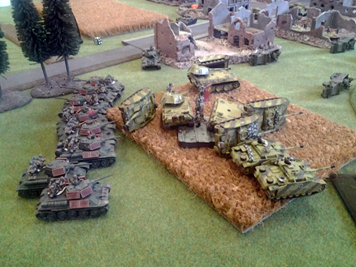 |
The first book in my collection was Barbarossa and the last book on the shelf was Berlin. I’d always figured that medals at my, thus far imaginary, competitions would be Iron Cross shaped (which they were), so Iron Cross: Barbarossa to Berlin was conceived.
From the start, I knew I wanted a team element of some kind in the competition. I originally considered a doubles format, but seeing as how the competition was about the Axis versus the Soviets that really dictated things. I wanted my players to feel like they were really part of a team and that their individual efforts (good or otherwise) were contributing to an overall team goal. So it would be two teams that would play through the general progress of the Eastern Front campaign over six games.
|
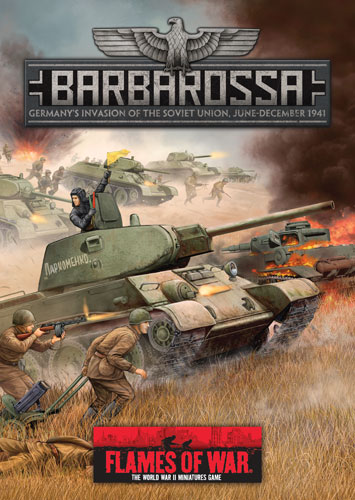 |
I’m a big believer in player agency (making their own decisions) and so I decided to add an untried element to manage player / table matching. Let the players decide! By providing the army lists ahead of time I figured the teams would plot and scheme about who could play who and this group consensus would mitigate a lot of problems that crop up with mismatched armies caused by random draws. To ensure a degree of balance I instituted a competition specific rule that the Axis players would be attacking in games one, three and five irrespective of any auto attack / defence rule their company may have normally had. Conversely, the Soviet players would be the attackers in games two, four, and six. So the attacking player would choose their opponent and the challenge couldn’t be declined. However, each player could only choose to attack a player once during the competition (I figured that this might lead to some great grudge matches later in the competition).
The last major issue was how to manage army lists across three different periods where the equipment evolved dramatically as did doctrines and force compositions. I decided to have an increasing amount of points as the war progressed to allow for the more expensive units that both sides fielded. The only constraint I put on players was that they had to have the same type of company (Tank, Mechanised or Infantry) and where practicable the company had to follow a logical progression; for example moving from a Red Army / Red Banner Strelkovy Batalon in Early-war to a Guards Strelkovy Batalon in the Mid and Late-war periods.
|
|
The image to the right is a snippet from one of the Axis players lists.
Lastly, fundamental to me in a themed competition was having a cohesive narrative that tied everything together; essentially turning a collection of one-on-one miniature wargames into a story. I decided to do this through the mission briefings.
|
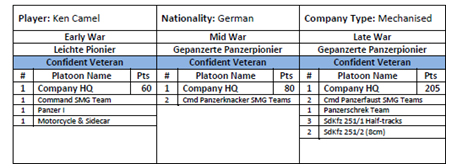 |
|
I created bespoke mission briefings for each team that included the standard scenario set up rules, but also included a narrative based on the current situation, mission and available intelligence.
For example in the first Early-war mission ‘Cemetery Hill’ (a Hasty Attack mission) it reflected the German advance into Lithuania:
German Situation
Panzergruppe 4 is tasked with the support of Army Group North. Attacking from our assembly area near Tilsit on the Memel, the armoured spearheads of 1. and 6. Panzerdivisions and SS-Totenkopftdivision have driven straight into the Soviet defences covering the Baltic States. Resistance has been light but has begun to stiffen along the main highway. We have to, therefore, explore the secondary highway, which we will hit from the east.
Russian Situation
Comrade Captain, the fascist invaders have violated the borders of the Motherland. For the last two days, large mechanised forces have been pouring past our position along the main highway. We have all heard the sounds of battle in the distance, but we are unsure of what is happening. The last time we heard from our Regimental CP was yesterday morning. We have not been resupplied since then and the runner we sent earlier today has not returned.
In Part Two, I’ll cover off the myriad special rules and competition specific factors and the tournament’s pièce de résistance, the themed catering.
~ Tony.
View Tony's Iron Cross Mission Briefings here... |
Last Updated On Wednesday, November 30, 2016 by James at Battlefront
|
|
|